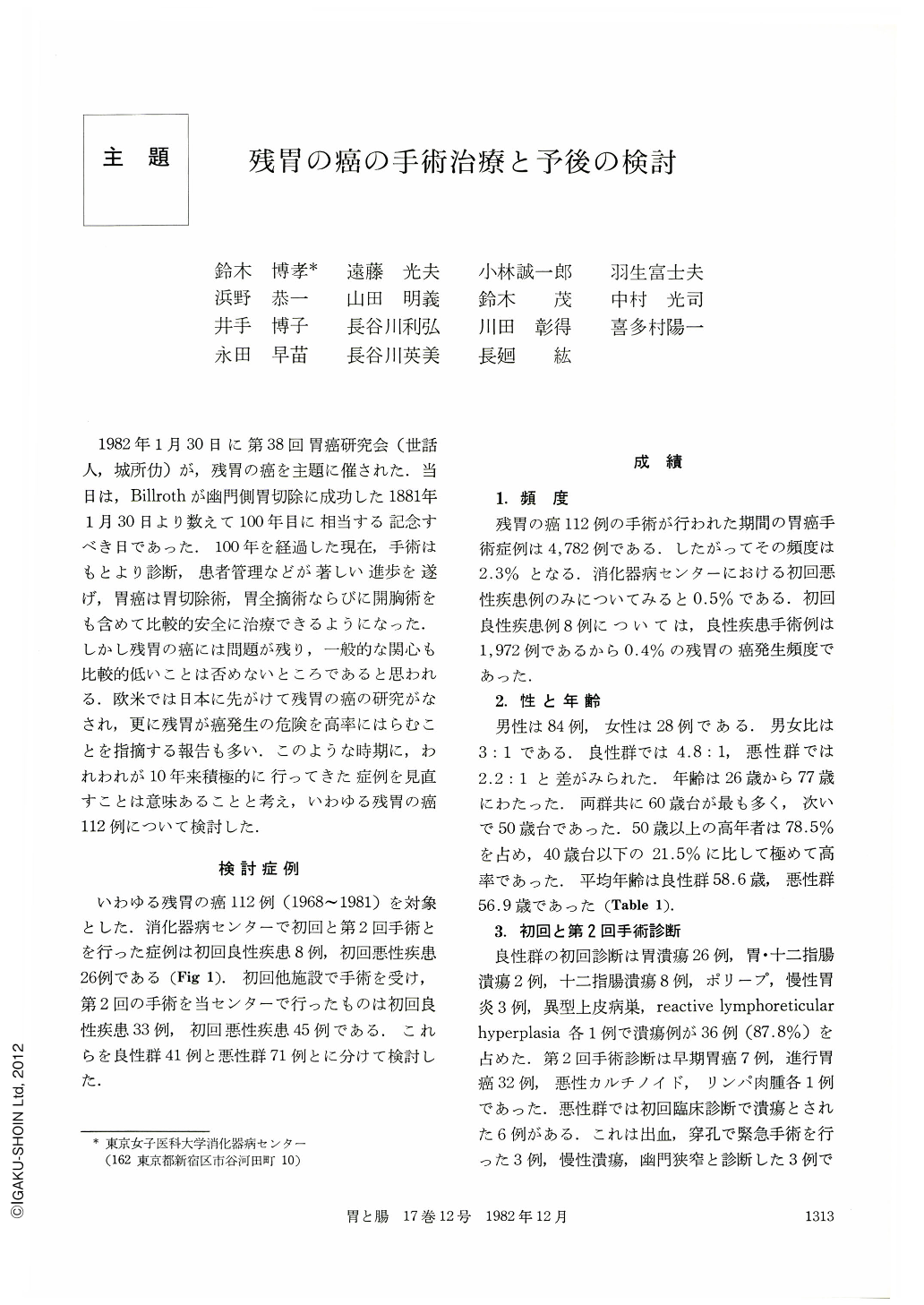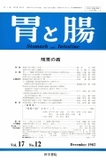Japanese
English
- 有料閲覧
- Abstract 文献概要
- 1ページ目 Look Inside
- サイト内被引用 Cited by
1982年1月30目に第38回胃癌研究会(世話人,城所校仂)が,胃の癌を主題に催された.当日は,Billrothが幽門側胃切除に成功した1881年1月30日より数えて100年目に相当する記念すべき日であった.100年を経過した現在,手術はもとより診断,患者管理などが著しい進歩を遂げ,胃癌は胃切除術,胃全摘術ならびに開胸術をも含めて比較的安全に治療できるようになった.しかし残胃の癌には問題が残り,一般的な関心も比較的低いことは否めないところであると思われる.欧米では日本に先がけて残胃の癌の研究がなされ,更に残胃が癌発生の危険を高率にはらむことを指摘する報告も多い.このような時期に,われわれが10年来積極的に行ってきた症例を見直すことは意味あることと考え,いわゆる残胃の癌112例について検討した.
It is said that partial gastrectomy on the pyloric side due to benign diseases would run a higher risk of developing cancer of the gastric remnant. In Billroth Ⅱ method cancer would most often be seen at the sutured site of anastomosis. In Japan where gastric cancer is of high incidence, cancer of the remnant stomach cannot be neglected. We have studied here 112 patients (4l. with initial benign diseases and 71 with malignant ones) regarding the methods of operation and prognosis of the patients.
The initial operation was partial resection of the stomach on the pyloric side in 91.1 per cent (B-Ⅰ 53 patients, B-Ⅱ 49 patients) and resection on the cardiac side in 7.1 per cent (8/112) and others. Diagnosis at the second operation was early cancer in 11 patients, advanced cancer in 96 and gastric sarcoma in 5.
In the second operation total resection of the remnant stomach accounted for 80 per cent (65/85) and thoracoabdominotomy and others for 15.3 per cent (13 /85). Resection of other organs affected by cancer accounted for 52.9 per cent (45/85). In 75 per cent of these individuals was conducted excision of more than one organs invaded by cancer.
The rate of resection was 75.9 per cent (85/112). Curative resection amounted to 51.8 per cent (44/85).
The rate of lymph node metastasis was 69.4 per cent (59/85). In patients with malignant diseases from the outset it was high as 76.9 per cent. Resection of affected lymph node metastases varied according to the methods of the initial operation and we think R3 resection in the General Rules for the Gastric Cancer Study in Surgery and Pathology is very important. Removal of lymph nodes is requisite for those of lower paraesophagus, diaphragm, splenic hilus, pancreas and of the base of celiac artery. In addition, resection of lymph nodes in the pancreatic head and those of hepatoduodenal ligament in Billroth Ⅰ method is not to be neglected, while in Billroth Ⅱ method removal of lymph node is necessary in the regional mesentery at the site of anastomosis and of the basic part of mesentery.
As for prognosis, the five-year survival rate of patients with curative resection was better than we had expected: 66.7 per cent (10/15). However, the overall five-year survival rate of patients who had undergone resection was as low as 30.3 per cent (10/33). Patients with non-curative resection did not survive more than three years. Eighty-five per cent of them died within one year.
We have classified cancer of the remnant stomach into three types: primary cancer of the gastric remnant 34.8 per cent (39/112); residual cancer of the gastric remnant 19.6 per cent (22/112), and recurrent cancer of the remnant stomach 45.5 per cent (51/112).

Copyright © 1982, Igaku-Shoin Ltd. All rights reserved.


